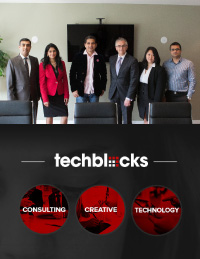IT solutions that put customers first
By Cheryl Long
Some information technology (IT) companies are strictly about the problem. They diagnose it, suggest ways to fix it and offer follow-up if or when things go wrong. TechBlocks, headquartered in Vaughan, Ontario, takes a different approach. It’s less about a specific problem or challenge and more about the customer … and their customers. It’s a unique approach, and one that is spelling success for a company that describes itself as having a small footprint but big impact.
Business Elite Canada spoke recently with TechBlocks founder Prashant Kumar, also known as El Capitan and Peter Goral, AKA The Artist. The catchy titles are part of the company’s stylish web site, but they also take a more serious note with a mission statement that emphasizes “a unified passion for creating customer-first solutions, building partnerships and transforming businesses.” There’s no question that the customer does indeed come first when working with TechBlocks — it’s a practice they take very seriously.
Though the company was launched in 2007, its transformation began in earnest four years ago, Kumar said. Their initial four employees and one office has grown to a staff of 27 in Canada, another office in India employing about 100 people and a third location in Houston, Texas, serving one of TechBlocks’ largest clients. Today, they provide a range of solutions that includes customer relationship management, mobile applications and responsive web sites, content and document management, cloud technologies, e-commerce and business intelligence reporting.
Here’s a look at this innovative IT company that prides itself on blending consulting, creativity and technology in a way builds long-standing partnerships and brings success to their clients.
Q: To what do you owe your success?
A: There are three ingredients in the TechBlocks recipe for success — a customer first policy, combining business acumen with technology and design, and embracing a culture of innovation. Secondly, TechBlocks not only cares about their clients and employees, but their customers’ customers. Relationships between businesses and IT firms have often been marriages of convenience, Kumar said, and created a level of distrust between the two groups. It doesn’t need to be that way, he explained. “We treat them as partners. We share accountability and responsibility of their goals by understanding their visions and KPIs (key performance indicators).”
The TechBlocks team has also helped their company stand out among its peers, and build a strong reputation among their customers. “We owe our success mostly to the most valuable assets that we have — our people and our cultural values,” Kumar said. “They’re our keys to success. We bring in the right people with the right values.”
Q: How do you stand out from your competitors?
A: It’s a result of being true business partners and not simply IT consultants. “We are a professional services firm; we do application development, technical strategy, managed services … we’re very obsessed with our customer first policy. It comes out at every stage and in every conversation,” Goral explained. They work with each client using a customized plan designed to bring their go-to-market requirements and strategy to fruition. Competition is fierce and the faster companies can go to market with a new product or service, the more successful they will be.
Q: How do you ensure success for your clients?
By utilizing a performance-based delivery process, TechBlocks is able to align their own strategies with the goals of their clients and increase the odds of success. They begin with research and strategy, immersing themselves in the client’s problem to identify insights and opportunities. Building and then delivering a solution is followed by a thorough review. Tools to measure performance and accountability are used to optimize the customer’s experience. It’s the way TechBlocks helps their customers become agile, Goral said.
Q: Who are your typical clients?
A: Mid-market and SMB (small and medium businesses). Their list of success stories includes a number of well-known names including Workopolis, Koodo, Just Energy, Telus, Colliers International, SmartCentres and Thomson Carswell, among others.
Q: What are the most important trends you see in the IT marketplace?
A: “The way technology is changing, how we interact with the world, ease of information and information delivery.” Mobility is a primary game changer, and statistics show that four out of five North Americans prefer to shop online, Kumar said. Mobile users are exceeding their desktop counterparts and that means mobile-friendly applications are more important than ever before.
The Internet of Things is another area that is growing rapidly, he said, and consumers are attracted to intuitive ease of use of these products. For example, the Internet of Things through voice-activated devices allows you to turn on the lights in the house before you arrive home or reads your emails out loud during the evening commute; voice-activated devices are part of a future that’s just around the corner. Finally, cloud-based computing continues to grow in popularity and reliability, providing companies with options for lowering overhead and increasing flexibility.
Q: What are the common challenges facing companies that want to transform their organizations?
A: Embracing the culture of innovation and out-of-the-box creativity, and designing from the experience rather than the infrastructure are areas that some businesses find difficult to embrace. TechBlocks tries to leverage what is already working for their clients, focusing on small goals and making a point of testing and improving along the way. It also means focusing on the best experience for the customer, and providing options in the form of a technology roadmap that will supplement that experience.
“Rather than replace or dismiss something that’s worked 70 percent of the time, sometimes it’s only an enhancement that’s required,” Goral explained. “That gets you a lot of traction. It adds authenticity and saves money.” Building on a client’s ideas and implementing new solutions incrementally is an effective way to encourage change without overwhelming them. Showing “key wins in a short period of time” can keep things moving in the right direction.
Q: What is your favourite transformation project you have worked on so far, and why?
A: One of the most interesting clients they have worked with to date is Qualifirst Foods. Qualifirst sells gourmet ingredients to some of Canada’s top chefs, restaurants and home chefs, selling more than 2,000 gourmet ingredients handpicked from 60 different countries. There are many factors that make Qualifirst such an interesting client, Kumar said. “For starters they have a highly intelligent and highly technical CEO. Ray has a very clear vision of the omni-channel experience that he wants both his B2B and B2C customers to have.”
Q: What is omni-channel?
A: On the front end, omni-channel is about the ability to provide a seamless, personalized and unified experience for your customers in all of the possible touchpoints they may have with your brand, regardless of channel and device, Goral said.
Q: What are the drivers of omni-channel?
A: With so much access at their fingertips at any moment, consumers are highly knowledgeable, demanding and more engaged with their favourite brands. Customers want their favorite brands to not only know who they are, but they also want these brands to show them that they know them at every engagement point. They don’t want to receive marketing offers of products they will never be interested in, and they want customer support to know what they purchased, when they purchased and what they will likely purchase next, Goral said.
Q: What are the technology implications of building an omni-channel experience?
A: “To successfully design and build omni-channel experiences, there are many back-end considerations. For example, we like to start with reviewing the systems or applications clients currently have in place. Are they up for withdrawal soon? Will they need to be upgraded? Can we build on top of their existing platform? What are the best of breed solutions that can talk to these systems? How will data flow from one system to another? What are the business processes? What business process can be standardized and automated? And from which system should that happen? What are the KPIs? How do we track and measure our results? How will they be communicated? What channels do we need to provide them in?” Kumar said. “In addition to all the front-end considerations, who will be visiting our site? How will they navigate through our site? What information gets sent back to the systems? When do we communicate to them? What will we say?”
Q: Is omni-channel only relevant to retailers?
A: Not at all. We see this in supply chain companies, manufacturing, telecommunications, health care … While retail is the most prominent example of the need for omni-channel experiences, it is relevant and can be applied to almost any industry.
Q: With so much to consider where should they start?
A: “That’s where we come in. Our goal as consultants is to simplify the process for companies. We want to reduce the complexity and the noise for our clients. Once we understand their business problem and what their goals are, we take all that away and source the best technologies and systems to build them a system that fits their needs,” Kumar said. “And this doesn’t have to be a huge investment either. We can work with the systems they have in place, deploy solutions in a phased or tiered approach, and work with any budget. We are always willing to put our skin in the game. We will build proof-of-concept solutions for nominal bare minimum costs for customers to assess if these solutions are right for them.”
Q: What are your plans for TechBlocks in the next two to five years?
A: For years now we have built amazing award-winning solutions for our clients, but we have been so focused on our clients and on their success that we had forgotten to promote our success. We are expecting to triple – no quadruple – in five years and you can definitely expect to hear more about TechBlocks as we continue to reface IT consulting with our new age approach.
To learn more about TechBlocks, visit www.tblocks.com.







